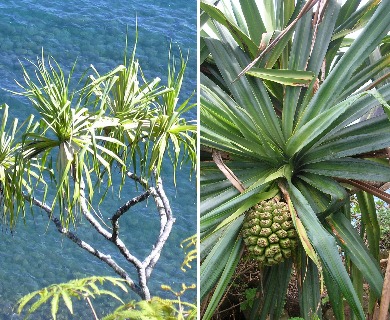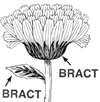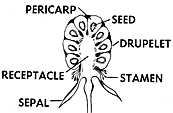Hala
Pandanus tectorius
Pandanus family (Pandanaceae)
Native species (indigenous)
Picturesque tree of coasts and lowlands recognized by the many large prop roots around the short, smooth light gray trunks, by the few widely forking stout branches, ending in a cluster of many crowded, spirally arranged large strap-shaped leaves with saw- edges, and by the resembling a pineapple.

©2003 Forest And Kim Starr
Leaves long and very narrow, thick and leathery, about 3 ft (0.9 ) long and 2 inches (5 ) wide or to twice that size, but crowded, with broad clasping base, parallel saw- edges, and many inconspicuous parallel side veins, and ending in a long tapered drooping point. The upper surface is shiny green, the lower surface dull light green with spines along the Dead brown leaves hang down and gradually fall away.
Two kinds of trees are distinguished not only by their flowers but by their trunks. Flowers are male and female on different plants (), small, and without and Male flowers are very numerous in drooping clusters 1–2 ft (0.3–0.6 ) long from the center of a cluster of leaves, and very fragrant. They consist of many 1⁄8–1⁄4 inch (3–6 ) long, crowded on threadlike branching stalks along an axis () with several spiny-edged pale yellow, very fragrant ending in a long, very narrow point. Female flowers in compact greenish heads have densely crowded with colored
The multiple (syncarp) borne singly on a long stalk, is a large hard heavy ball 4–8 inches (10–20 ) in diameter, composed of 40–80 (). Each is 1 1⁄2–2 3⁄4 inches (4.7 ) long and 3⁄8–3⁄4 inch (1–2 ) wide, angled and slightly flattened, shiny pale yellow to orange to red, hard and fibrous, containing usually 5–11 seeds or empty cells. These bright-colored fragrant are scattered by animals that eat the sweetish pulp. The soft orange pulp was also used as food by Hawaiians in times of famine. The old dried are spongy and probably float to other islands.
Trunks of male trees are hard and solid throughout and have wood that is yellow with dark brown fiber bundles, very strong, but brash when subjected to a sudden load and difficult to split. Those of female trees are very hard in the outer part, but soft and fibrous or juicy within. Elsewhere, trunks of female trees have served as water pipes after removal of the pith.
Hawaiians utilized most portions of the plant for various purposes. The leaves (lau) served as thatch in houses and were plaited into baskets and mats, or floor coverings. A roof of lauhala leaves is said to last about 15 years in low rainfall coastal areas while one of coconut leaves will last only 3 years. Finely divided lauhala is used to make hats. The dry weeds with fibrous ends were employed as brushes in dying bark cloth. Parts of the were sliced into pieces that were strung into leis or garlands with leaves of other plants intertwined.
Hala is common through the Hawaiian Islands in lowlands, especially windward sides along coasts and from sea level to 2000 ft (610 ).
Special areas
Keahua, Waimea Arboretum, Foster, Volcanoes.
Champion
Height 35 ft (10.7 ), c.b.h. 4.5 ft (13.7 ), spread 40 ft (12.2 ). Keaau, Hilo, Hawaii (1968).
Range
Through the Hawaiian Islands and southwestward in the South Pacific Islands to northern Australia, New Guinea, west to Philippine Islands, Moluccas, and Java.
This is the only species of Pandanus native in Hawaii, according to a conservative classification. It was formerly united under P. odoratissimus L. f. of the South Pacific region.
Other common names
screwpine, puhala, lauhala, pandanus; kafu (Guam, N. Marianas); ongor (Palau); fach (Yap); fach (Truk); kipar (Pohnpei); moen (Kosrae); bop (Marshalls); fala (Am. Samoa)
Also, color varieties: hala (yellow), hala’ula (orange), hala lihilihi’ula (red yellowish below), halapia (pale yellow).
The name screw-pine is suggested by the leaves arranged spirally like a screw and by the ball-like similar to a pine cone.
Several species have been introduced as ornamentals, illustrating white-bordered or striped leaves, short leaves, and large









